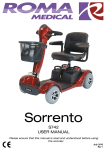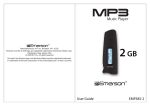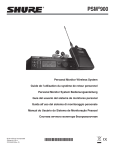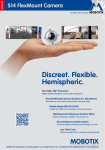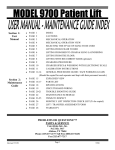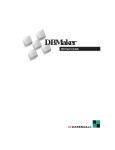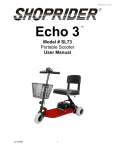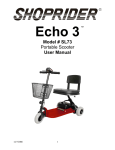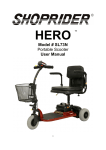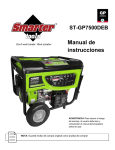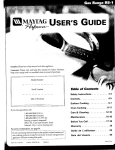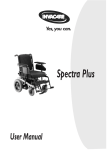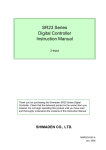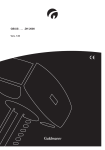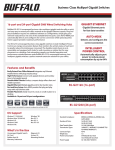Download User Manual - SMT Health Systems
Transcript
Ceiling Lift User Manual For Technical Support Call SMT HEALTH SYSTEMS 1380 Legion Rd Detroit Lakes, MN 56501 1-800-725-7761 Ask for “Ceiling Lift Tech Support” Or Call your local SMT Representative www.smths.com © Guldmann · 1071/07/06· SIDE 75 SERVICE GH2 Service manual GH2 – Service manual 7.01.00 SERVICE GH2 Service manual 7.01.01 GH2 – Demounting of covers Opening of end cover To open the end cover, press against the grooved marks as shown in the illustration and pull outwards. It might be necessary to press hard. Demounting of side cover Tip up the end covers and loosen two setscrews in each end with a 3 mm / 1/8’’ Allen key. Demounting of side covers © Guldmann · 1071/07/06· SIDE 76 Move the side covers slightly apart from one another and demount the end covers. Then demount the side covers SERVICE GH2 Service manual 7.01.02 GH2 – Replacement of batteries Demounting of batteries Turn the yellow battery lock anti-clockwise and demount the batteries. Demounting of battery connections Remove the female push-on terminals from the batteries. Note the position of wires and polarity of connections. Mounting of new batteries © Guldmann · 1071/07/06· SIDE 77 Mount the batteries in reverse order of the demounting. The wires of the lower battery MUST be placed in the gap in order not to be jammed. SERVICE GH2 Service manual 7.01.03 Positioning of batteries © Guldmann · 1071/07/06· SIDE 78 Position the poles of the batteries as illustrated. ALWAYS BE SURE that polarity is as shown in the illustration. Check that the wires are placed in the gap without being jammed between battery and chassis. SERVICE GH2 Service manual 7.01.04 GH2 – Replacement of strap Unplug the lifting motor (and drive motor if installed) Pull the wires of lifting motor (and drive motor if installed) out of the wire groove Demounting of bracket for the printed circuit board To release the bracket for the printed circuit board, pull the front hook outwards as shown in the illustration. © Guldmann · 1071/07/06· SIDE 79 Then pull the bracket towards the front hook and outwards in order to disengage the hooks at the end of the bracket. SERVICE GH2 Service manual 7.01.05 Tilt bracket for the printed circuit board Tilt the bracket. Then demount strap tightener and spring. Removal of retaining ring Remove the retaining ring with retaining ring pliers (no. 2 for the outer retaining rings, diameter 26 mm / 1 1/16’’). Demount the reel plate. Demounting of strap © Guldmann · 1071/07/06· SIDE 80 Demount the strap with sole and cylinder pin. SERVICE GH2 Service manual 7.01.06 Mounting of new strap IMPORTANT: The strap MUST be mounted as shown in the illustration. Be sure to position the plane surface of contact anticlockwise (i.e. against the pulling direction); then secure the strap with the original cylinder pin. The length of the folded part of the strap should be 100 mm / 4’’. Mount the strap as shown in the previous illustration. Mounting of strap tightener Reinstall reel plate and retaining ring CAREFULLY. Mount spring and strap tightener. The strap tightener should be positioned UNDERNEATH the strap. If necessary, lift the strap with the 3 mm / 1/8’’ Allen key when mounting the strap tightener. Push down strap tightener © Guldmann · 1071/07/06· SIDE 81 Before mounting bracket for the printed circuit board, push the strap tightener slightly down as shown in the illustration. If necessary, the 3 mm / 1/8’’ Allen key can be used as leverage by placing it above the strap tightener and below the emergency stop switch. SERVICE GH2 Service manual 7.01.07 Mounting of bracket for the printed circuit board Only when the strap tightener has been pulled down, the bracket for the printed circuit board can be mounted without the micro switch on the back of the printed circuit board being jammed behind the strap tightener. Note: Make sure that the hooks at the end of bracket of the printed circuit board have engaged with the side plate before the front hook is engaged. Inspecting the strap tightener © Guldmann · 1071/07/06· SIDE 82 Check through spyhole in the bracket that the lever of the micro switch rests ON TOP of the strap tightener. Check the function of the micro switch by tightening and slackening the strap. When pulling the strap lightly the micro switch should make a click. SERVICE GH2 Service manual 7.01.08 GH2 – Replacement of the hand control Demounting of hand control Unscrew fork terminal and remove it from the emergency stop switch, and remove the 6-way connector from the printed circuit board. Disengage the hook of the wire suspension and push the wire suspension sideways out of the chassis. Wire suspension The route of the wire through the labyrinth of the wire suspension. © Guldmann · 1071/07/06· SIDE 83 Mounting of wire suspension IMPORTANT! Make sure that the chassis does not cut into the wire when mounting the wire suspension. Press the wire into position in the track, before CAREFULLY pushing the wire suspension into position. Check that the hook is engaged behind the chassis. Insert the 6-way connector into the printed circuit board. SERVICE GH2 Service manual 7.01.09 GH2 – Mounting of side covers and end covers Side covers Position the side covers with the lobes facing the receptacles on the chassis. Make sure that the tension pieces are located behind the lobes. Check that wires are not being jammed. Make sure that the wire of the power intake is positioned correctly in the opening on top of the chassis. When both side covers have been mounted, tighten setscrews in the tension pieces lightly. End covers It is possible to mount the end covers after having mounted the side covers because the end covers are very flexible. © Guldmann · 1071/07/06· SIDE 84 Mounting of end cover Fit the end cover into the slot on one side by means of the hinge in the corner of the cover. Position the end cover at an angle of approximately 45º, as shown in the illustration, in order to ensure that the hinge in the opposite corner of the cover faces the groove in the slot. © Guldmann · 1071/07/06· SIDE 85 SERVICE GH2 Service manual 7.01.10 Bend the end cover and fit it into the slot on the other side through the groove. © Guldmann · 1071/07/06· SIDE 86 SERVICE Main inspection of GH2, GH2 HD and rail system 7.02.00 Performance testing GH2 ang GH2 HD • The performance test provides a first-hand impression of the status of the entire system. A note is made of any instances of non-compliance which are subsequently investigated further during the main inspection. • The hoist is run through the entire system by the technician, who makes a general observation of the system while all system functions are tested. • Testing of up/down function. • Testing of drive motor, if any. • Checking of any undesired noises from the wheels. • Checking of any undesired noises from the gears/motor. • Testing of Combi-lock, switch tracks and turntables, if any. Main inspection GH2 and GH2 HD • Remove covers and follow the procedure below, if necessary together with the electrical functional description for GH2 ang GH2 HD. • Check transformer min. 24 V AC • Check voltage from the transformer to the charging station, including any room-covering charging station, thereby ensuring that the cable connections are correct. • Check batteries: Measure battery voltage on both batteries without load. It must be above 12.0V and the difference between the two batteries must be max. 0.3V. Now measure the voltage with load (60-80 kg/132-176lbs). The rate of speed at which the voltage drops must be the same on both batteries, and the difference between the two batteries must be max. 0.3V. • Check emergency stop and emergency lowering function with a load corresponding to 85 kg/187lbs. • Check endstop down – first without load on the lifting strap. It should not be possible to lower. Then test with the weight of the lifting hanger on the strap. It should now be possible to lower. • Check endstop up. Run lifting strap all the way up and against the stop. This should cause the micro switch to stop the lifting function immediately. The same should apply when the strap is at an angle of more than 45º relative to the hoist lengthways and 10º crossways. • Check lifting strap for correct installation and check for cut threads. If the edges of the strap are very worn due to swings or if there are any other signs of wear, the strap should be replaced. Also check the hoist to identify any sharp edges or burrs. Any defects must be repaired before fitting of the new strap. Follow the instructions on the fitting of lifting straps. • Check trolley – as regards the fitting of the trolley to the hoist, locking rings must be fitted at either end of the axle which holds the trolley. • Check coating if the hoist is coated. It must be ensured that the coating remains functional. If not, the hoist must be recoated using Silicone Spray – Sil Slip A. • Fit covers. • Carry out performance test of the entire system with rated load. Rail system in general • Carry out a performance test of the entire system with rated load. • Check that the system is completely level. • Check the bracket to ensure it has been correctly tightened. • Check rail connections to ensure correct positioning of cylinder pins and rail connectors. • Retighten all endstops and check for installing safety split pin. • The rail system should be marked with the maximum load, cf. the distance between the fittings. Combi-locks • Function test, including checking the diode function on the manual control. • Check transformer, 24 volt AC. • Check attachment to rail (remove covers). • Check that the tongue does not subject the safety lock on the traverse rail to a maximum load – the safety lock must not fully open. If this is the case, the combi-lock must be adjusted. • Both safety locks must be checked manually and electronically – must return normally without problems. Switch track manual/electrical • Function testing. • Check transformer 24 V AC. Turntable • Function testing. • Check transformer 24 V AC. • Check endstop function – the turntable rail must be completely in line with rails on either side of the turntable. If this is not the case, the rail system must be adjusted, and if the turntable turns too much, the cover plates must be removed and the end stop adjusted. GB/US . . . . Guldmann ABC Slings GB . . . . . . . Guldmann ABC Slings ACTIVE Micro Plus Polyester Size: XS-XXL ACTIVE Trainer Polyester Size: Kids – XL BASIC Basic Polyester/Net Size: Kids-XXL BASIC High Polyester/Net Size: Kids – XXXL BASIC Low Polyester/Net Size: XS – XXL CUSTOM Amputee Polyester Size: S-L CUSTOM Sit-On Net Size: Standard/Wide CUSTOM Sit-On High Net Size: Standard/Wide TURNER Polyester LIMB SLING Polyester REPOSITIONING SLING Polyester © Guldmann GB-1005/06/07 Item nos: xxxxx-xxx C ontents © Guldmann GB-1005/06/07 Active Micro Plus. . . . . . . . . . . . . . . . . . . . . . . . . . . . . . . . . . . . . . . . . . . . . . . . . . . . . . . . . . . . 5 Active Trainer . . . . . . . . . . . . . . . . . . . . . . . . . . . . . . . . . . . . . . . . . . . . . . . . . . . . . . . . . . . . . . 7 Basic Basic. . . . . . . . . . . . . . . . . . . . . . . . . . . . . . . . . . . . . . . . . . . . . . . . . . . . . . . . . . . . . . . . 9 Basic High. . . . . . . . . . . . . . . . . . . . . . . . . . . . . . . . . . . . . . . . . . . . . . . . . . . . . . . . . . . . . . . . . 11 Basic Low . . . . . . . . . . . . . . . . . . . . . . . . . . . . . . . . . . . . . . . . . . . . . . . . . . . . . . . . . . . . . . . . 13 Custom Amputee. . . . . . . . . . . . . . . . . . . . . . . . . . . . . . . . . . . . . . . . . . . . . . . . . . . . . . . . . . . 15 Custom Sit-On. . . . . . . . . . . . . . . . . . . . . . . . . . . . . . . . . . . . . . . . . . . . . . . . . . . . . . . . . . . . . 17 Custom Sit-On High . . . . . . . . . . . . . . . . . . . . . . . . . . . . . . . . . . . . . . . . . . . . . . . . . . . . . . . . 19 Turner . . . . . . . . . . . . . . . . . . . . . . . . . . . . . . . . . . . . . . . . . . . . . . . . . . . . . . . . . . . . . . . . . . . 21 Limb sling – at the bed. . . . . . . . . . . . . . . . . . . . . . . . . . . . . . . . . . . . . . . . . . . . . . . . . . . . . . 23 Limb sling – at the wheel chair. . . . . . . . . . . . . . . . . . . . . . . . . . . . . . . . . . . . . . . . . . . . . . . . 26 Repositioning sling . . . . . . . . . . . . . . . . . . . . . . . . . . . . . . . . . . . . . . . . . . . . . . . . . . . . . . . . . 27 Repositioning sling – use of different lifting hangers when repositioning patients. . . . . . . . . 29 Laundering recommendation. . . . . . . . . . . . . . . . . . . . . . . . . . . . . . . . . . . . . . . . . . . . . . . . . . 30 Sling inspection checklist . . . . . . . . . . . . . . . . . . . . . . . . . . . . . . . . . . . . . . . . . . . . . . . . . . . . 30 Safe Operating Practices with Slings . . . . . . . . . . . . . . . . . . . . . . . . . . . . . . . . . . . . . . . . . . . 31 WARRANTIES. . . . . . . . . . . . . . . . . . . . . . . . . . . . . . . . . . . . . . . . . . . . . . . . . . . . . . . . . . . . . 34 © Guldmann GB-1005/06/07 A ctive M icro P lus Place the sling on the user’s shoulders and/or the wheelchair’s backrest. To ensure sling is centered, the center stripe should follow the user’s backbone. Use the correct hanger width. Have the user lean forward. Position the upper edge of the sling at the lower edge of the shoulder blade. © Guldmann GB-1005/06/07 Pass the upper straps under the armpits. However, not higher up than a minimum of two finger widths between sling and armpit. Tighten the support belt. If it is tight it provides support around the upper body to prevent sliding out of the sling. Place the leg support under the thighs and as far up towards the crotch as possible. Try to lift using your legs and not your arms and back. Cross the les straps before attaching to the hanger. Check that the length of the upper lifting strap fits the length of the leg support. If you are lifting a user with low muscle tone you should hold his/her legs/knees together. Active Micro Plus can be applied from a sitting position in bed. © Guldmann GB-1005/06/07 Lift until all straps are taut, check the straps’ mountings. A ctive T rainer Put the sling on from the front and have the user put his/her arms through the lifting straps. Then cross the support straps behind the user. If leg straps are used, pass them under the thigh and attach them to the sling. Be careful that they are not too tight fitting in the crotch. Use the correct hanger width. As an alternative the sling can be suspended on the lifting hanger. © Guldmann GB-1005/06/07 It is then attached from the front. When using the hanger (bar) with Active Trainer, position the hanger (bar) to the rear of the user’s head while attaching the straps and prior to the user coming to standing. Check that the support straps are correctly tensioned. There should be no more than max 15 cm / 6 inch space at the back where the rear straps cross in between the two halves of the trainer sling. Make sure that the size of the lifting hanger fits the user. Have the user lean slightly forward and lift a bit until the strap stretches. Check the tension of the support straps’ again. Then start the actual lift © Guldmann GB-1005/06/07 You must not lift to such a height that the user is lifted off the floor. B asic B asic Place the sling on the user’s shoulders and/or the wheelchair’s backrest. To ensure the sling is centered, the center stripe should follow the user’s backbone. Use the correct hanger width. Have the user lean forward. Put your hand in the sling pocket and allow your hand and the sling to follow the back down to the chair cushion. Hold your hand between the user’s hip and the inside of the sling at the back support and press down the sling. © Guldmann GB-1005/06/07 At the same time pull the leg support forward towards the knees with your other hand. Place the leg support under the thighs. Try to lift with your legs and not with arms and back. If the legs are heavy, ask a colleague to help you to lift. Cross the leg straps before attaching to the hanger. Check that the length of the upper lifting straps fits the lifting strap of the leg supports. Lift until all the straps are taut and check all mountings. To lift user evenly, match colors on the loops of each strap, such as grey to grey or green to green. To modify user’s position or comfort, differing loop colors can be used – consult with your Guldmann representative for assistance. Do not lift higher than necessary. Make sure to use the correct lifting hanger. Basic Basic can be applied from a lying position in bed as well as a sitting position in bed. 10 © Guldmann GB-1005/06/07 When putting user into a wheelchair, tip the chair slightly backwards and push against the user’s knees to get user as far back in the chair as possible. B asic H igh Place the sling on the user’s shoulders and/or the wheelchair’s backrest. To ensure the sling is centered, the center stripe should follow the user’s backbone. Use the correct hanger width. Have the user lean forward. Put your hand in the sling pocket and allow your hand and the sling to follow the back down to the chair cushion. Hold your hand between the user’s hip and the inside of the sling at the back support and press down the sling. © Guldmann GB-1005/06/07 At the same time pull the leg support forward towards the knees with your other hand. 11 Place the leg support under the thighs. Try to lift with your legs and not with arms and back. If the legs are heavy, ask a colleague to help you to lift. Cross the leg straps before attaching to the hanger. Check that the length of the upper lifting straps fits the leg support’s lifting strap. Lift until all the straps are taut and check all mountings. To lift user evenly, match the colors on the loops of each strap, such as grey to grey or green to green. To modify user’s position or comfort, differing loop colors can be used – consult with your Guldmann representative for assistance. Do not lift higher than necessary. Make sure to use the correct lifting hanger. Basic High can be applied from a lying position in bed as well as a sitting position in bed. 12 © Guldmann GB-1005/06/07 When putting user into a wheelchair, tip the chair slightly backwards and push against the user’s knees to get the user as far back in the chair as possible. B asic L ow Place the sling on the user’s shoulders and/or the wheelchair’s backrest. To ensure the sling is centered, the center stripe should follow the user’s backbone. If you have the correct hanger width, put arms, for example, outside. Have the user lean forward. Put your hand in the sling pocket and allow your hand and the sling to follow the back down to the chair cushion. Hold your hand between the user’s hip and the inside of the sling at the back support and press down the sling. © Guldmann GB-1005/06/07 At the same time pull the leg support forward towards the knees with your other hand. 13 Place the leg support under the thighs. Cross the leg straps before attaching to the hanger. Try to lift with your legs and not with arms and back. If the legs are heavy, ask a colleague to help you to lift. If support is required for the neck, a neck support cushion is available as an accessory. Check that the length of the upper lifting straps fits the lifting strap of the leg supports. Lift until all the straps are taut and check all mountings. Do not lift higher than necessary. It is the functional level that determines whether the arms should be inside or outside the sling. Users with paralysis should have the paralyzed arm on the inside of the sling where it will be supported. When putting user into a wheelchair, tip the chair slightly backwards and push against the user’s knees to get the user as far back in the chair as possible. Make sure to use the correct lifting hanger. Basic Low can be applied from a lying position in bed as well as a sitting position in bed. 14 © Guldmann GB-1005/06/07 To lift user evenly, match the colors on the loops of each strap, such as grey to grey or green to green. To modify user’s position or comfort, differing loop colors can be used – consult with your Guldmann representative for assistance. C ustom A mputee Place the sling on the user’s shoulders and/or the wheelchair’s backrest. Do you have the correct hanger width for stability? Have the user lean forward. Put your hand in the sling pocket and allow your hand and the sling to follow the back down to the chair cushion. Hold your hand between the user’s hip and the inside of the sling against the back support and press down the sling. © Guldmann GB-1005/06/07 At the same time pull the leg support forward towards the knees with your other hand. 15 Always begin by placing the leg support on the side that the stump is shortest. Have the user lean over towards the opposite side. Place the leg support underneath with your hand held flat. Then get the user to lean over to the other side and pull the leg support forward. Repeat the process with the other leg support, which should be layered underneath the first or upper leg support. When both the leg supports are in place under the user, put the top one through the inner strap guide and the bottom one through the outer strap guide. It means that the leg support that you started with will always go though the inner strap guide. Do not lift higher than necessary. Lift until all the straps are taut and check all mountings. 16 © Guldmann GB-1005/06/07 When the user is lifted, he/she will be tilted backwards for safety reasons and appropriate weight distribution C ustom S it- O n Sit-On slings must always be put on in a lying position. Bend or cross one leg (upper) towards the side you wish to roll the user. Pass the arm on the same side forward over the chest. Have the user turn his/her head in the same direction. The center stripe should end approximately at the end of spine, beginning of the pelvis. The lower edge of the sling should be positioned two finger-widths from the back of the knee. Turn the user onto his/her back and pull the sling out on the other side. © Guldmann GB-1005/06/07 Mount the lifting strap on the hanger. Change the bed’s position to sitting. Lifting using the Sit-On sling should always take place from a sitting position. Make sure to use the correct lifting hanger. 17 Lift until all straps are taut, but user is still sitting on the bed. Check all mountings. Attach the Velcro straps that will connect and hold together the upper and lower straps on each side. Check that the Velcro straps that hold the back and leg parts together have not become caught in the hanger. Note! You must not lift using these Velcro straps It is a good idea to lower the height of the bed first, whenever possible, before you lift the user. It feels more secure and you do not need to lift higher than necessary. Do these stages in reverse when the user is being put back into bed. 18 © Guldmann GB-1005/06/07 When putting user into a wheelchair, tip the chair slightly backwards and push against the users knees to get the user as far back in the chair as possible. C ustom S it- O n H igh Sit-On slings must always be put on in a lying position. Bend or cross one leg (upper) towards the side you wish to roll the user. Pass the arm on the same side forward over the chest. Have the user turn his/her head in the same direction. The center stripe should end approximately at the end of the spine, beginning of the pelvis. The lower edge of the sling should be positioned two finger-widths from the back of the knee. The upper edge of the sling will support the head. Turn the user onto his/her back and pull the sling out on the other side. Mount the lifting strap on the hanger. © Guldmann GB-1005/06/07 Change the bed’s position to sitting. Lifting using the Custom Sit-On High sling should always take place from a sitting position. Make sure to use the correct lifting hanger. 19 Attach the Velcro straps that will connect and hold together the upper and lower straps on each side. Lift until all the straps are taut and check all mountings. Check that the Velcro straps that hold the back and leg parts together have not become caught in the hanger. Note! You must not lift using these Velcro straps It is a good idea to lower the height of the bed first, before you lift the user. It feels more secure and you do not need to lift higher than necessary. Do these stages in reverse when the user is being put back into bed. 20 © Guldmann GB-1005/06/07 When putting user into a wheelchair, tip the chair slightly backwards and push against the users knees to get the user as far back in the chair as possible. T urner Turner is a triangular turning sling with two lifting straps on one side and one fastening strap to attach to the bed on the other side. The user lies on his/her back in the middle of the bed. The carer places his/her hand on the fastening strap for the bed, which is now passed under the user’s back, at the same time as using the palm of the hand to press the sling down into the mattress, compressing the mattress to create space, allowing carer’s hand and sling to pass beneath the user. © Guldmann GB-1005/06/07 The fastening strap is pulled as far as possible out on the other side to be attached to the frame of the bed. 21 The user is now put in a preparatory position for one sided turning. The user’s arms are put on his/her chest and legs are crossed. The sling’s lifting strap is now mounted onto the hanger in a ceiling or floor lift. The lift is now activated while the carer supports the user’s shoulders and hips. This will improve the user’s comfort while turning. It is a good idea to support the user’s head with a pillow. The user is now turned to the other side. 22 © Guldmann GB-1005/06/07 Do not operate the hanger higher up than necessary. L imb sling – at the be d If necessary the stiffener can be placed before use The Limb sling is placed beneath the lower leg, where it is most appropriate for the care task to be done. However, it ought not to be placed too close to the ankle joint. © Guldmann GB-1005/06/07 The Limb sling is pulled under the leg, taking care to keep a hand between the sling fabric and user’s skin, and is placed centrally beneath the lower leg, so that even amounts of sling are on each side. 23 The Limb sling is now mounted to the lifting hanger. If the Limb sling is used in connection with personal hygiene for bariatric patients, it can also be used as assistance to separate the thighs. 24 © Guldmann GB-1005/06/07 The Limb sling can also be utilized when fitting a lifting sling if the user has heavy or very heavy thighs or very compromised skin integrity. The lower leg is lifted with the limb sling and the leg strap of the lifting sling is placed beneath the thigh. © Guldmann GB-1005/06/07 The Limb lifter is lowered and removed. The same process is done for the opposite leg. 25 L imb sling – at the wheel chair The Limb lifter is lead under the thigh at the back of the knee joint. The Limb lifter is pulled through, taking care not to shear the user’s skin, so that it is centralized in relation to the thigh lengthwise. 26 © Guldmann GB-1005/06/07 The Limb lifter is mounted to the lifting hanger and the thigh can now be lifted slightly from the seat. The sling’s limb strap can now be placed either beneath the user’s thigh or be drawn out without putting strain on the skin. R epositioning sling The repo sling is placed under the patient centralized at the mattress and so that the top of the sling is in line with the top of the patient’s head. It is fine with exceeding textile higher than the head. By rolling the patient he is placed in the position prepared for side-lying and as a general rule the strap no 2 and 3 (counted from the patient’s head) are used. © Guldmann GB-1005/06/07 When the patient has been “rolled” to side-lying place relevant pillows to support the patient. 27 28 © Guldmann GB-1005/06/07 Hereafter the straps are removed from the lifting hanger. Repositioning sling . – use of different lifting hangers when repositioning patients The 2 straps nearest to the head of the patient are mounted in the cross hanger’s two lifting hooks closest to the head of the patient. The 2 straps closest to the feet of the patient are mounted to the cross hanger’s two lifting hooks closest to the patient’s feet. When the standard lifting hanger is placed perpendicular to the patient. The 3 (6) straps closest to the head of the patient are mounted in the hangers two lifting hooks closest to the head of the patient. Always mount the head straps at last. The 2 bottom straps are placed at the two hooks furthest from the head of the patient. © Guldmann GB-1005/06/07 When the standard lifting hanger is placed parallel to the patient. The straps are now placed similar to first drawing on this page illustrating use of the cross hanger. 29 L aun d ering recommen d ation 85° S ling inspection checklist Before using a Guldmann sling / accessory check the following*: Is the sling clean? Follow facility specific infection control and laundering procedures Is the sling’s label present, legible and complete? Missing, illegible or incomplete sling label(s) could compromise identification of appropriate size of the sling, function of sling, and or weight limit capacity of the sling Are the lifting straps and stitches intact? Look for broken or worn stitches Look for knots in straps Look for tears or fraying of straps Look for snags or punctures or holes Look for any particles in fabric of straps Is the fabric intact? Look for abnormal wear patterns, excessive wear, abrasive evidence Look for cuts or frayed fabric Look for unusual or significant discoloration Look for snags, punctures, tears, holes Look for frayed or insecure seams Look for any acid / caustic / thermal burns Look for changes in material consistency, e.g. increased stiffness Look for any imbedded particles * Not intended to represent all potential inspection steps. Potential damage may vary. Judgment of inspector/site prevails. 30 © Guldmann GB-1005/06/07 Are slings the original size and length without the use of knots, pins, tape or other methods to change the shape, shorten or lengthen them? S a f e O perating P ractices with S lings Considerations for damaged or defective slings and taking them out of service*: Consider removal of slings from service if any of the following conditions exist: 1 . . 3 . 4 . 5 . 6 . 7 . . chemical or caustic burns melting or charring of any part of the sling snags, punctures, tears or cuts broken or worn stitches missing, illegible or incomplete sling tag knots in any part of the sling abrasion other visible damage that causes doubt as to the strength of the sling Sling inspection is done for the protection of the patient, the caregiver, and the overall hospital site safety. A sling inspection system has additional benefit. Systematic sling inspection will assist in the identification of damage trends, potentially leading to cost effective suggestions and results. The inspection process can also help to identify inventory duplicity in certain sling types and sizes. Sling inspection system Development of a specific procedure and program for the inspection of slings at your facility is your best safeguard. Consider employing a three part system of inspection. Slings that are removed from service and are not capable of repair should be disposed of so they are unfit for any future use and can not find a way back into active inventory. 1) Initial This level of inspection is done at the time that the sling is received into your facility. The inspector should insure that no damage has occurred during transit, and also verify that the sling work load limits match those contained in the manufacturer’s catalogue. If your facility documents the sling inspection process through written inspection records, the paper trail should begin at this stage © Guldmann GB-1005/06/07 2) Frequent The frequent level of inspection should be done by the sling user before each use. The sling should be examined and removed from service if damage is detected. The sling user should also determine that the sling is proper for the patient conditions, care task required and the required weight capacity. 31 3) Periodic Your facility might want to consider implementing a program for a periodic level of inspection at regular intervals. The interval should be based upon the frequency of use, severity of the service cycle and information derived through the inspection process. Recommendations to prevent damage and enhance service life could be made by staff that perform the periodic inspections. If written inspection records are maintained, they should always reference the unique sling identification number, and be updated to record the condition of the sling. Not intended to represent all potential inspection steps or all potential aspects of product management program. Judgment of inspector/site prevails. Guldmann ™ * Not intended to represent all potential inspection steps. Potential damagemay vary. Judgment of inspector/site prevails. 32 © Guldmann GB-1005/06/07 Sling inspection technique* The sling inspection procedure should be thorough, systematic and consistent; both visual and “hands on” inspection techniques are recommended. Certain forms of damage are far more discernable through hands-on inspection, than by visual inspection. For example, fabric stiffness, crushed webbing, as well as, thinning fabric can be identified through tactile inspection. Visual inspection alone may not reveal all forms of sling damage. Once signs of damage have been identified, do not downgrade the work load limit of the sling, with the intent of continuing to use it, but at limited capacity or frequency. This is sometimes done to get more service life out of a damaged sling. The operating rule and standard should be: intact = use; damage = do not use. Consider the practice of documenting sling inspections through written inspection records. The documentation should include information such as: the name of manufacturer, the sling stock number, width and length, the unique sling identification number (important in differentiating similar slings), as well as the condition of the sling. Other important information might also include the date it was received or put into use at your facility and any special features (if applicable). A beneficial outcome of an inspection program would be the realization of repetitive forms of damage and the analysis that would lead to specific recommendations. Sample visual examples of synthetic sling damage* Chemical/caustic burns Broken stitching Crushed / Frayed webbing Knots © Guldmann GB-1005/06/07 Melting / Charring * sample visual images not intended to represent all types of potential damage 33 U . S . A . an d countries outsi d e the E U A . U sers gui d e Before using the product, read the entire operation manual including all warranties. B . WA R R A N T I E S The Guldmann lifting equipment is designed to be used for the lifting, transferring, and transporting of persons with a physical handicap who are not able to physically self transfer or who are temporarily incapacitated by illness, anesthesia or other causes. This lifting equipment is designed to relieve the users, their caregivers, and nursing personnel in the task of lifting elderly or handicapped people, thereby minimizing the risk of back injury during such lifting and transfer operations. If the product is used irresponsibly or for any use other than that described above or in the enclosed written instructions, the manufacturer’s warranty will be nullified and rendered void. There are no warranties which extend beyond the description in the enclosed written instructions. Guldmann warrants that its lifting equipment is free from defects in materials and workmanship under normal use. Guldmann warrants that the lifting equipment itself will perform substantially in accordance with the specifications set forth in the documentation provided with the equipment. The above express warranties are made for a period of 365 days from the date the lifting equipment is delivered to you as the first user. Your distributor will replace any lifting equipment which proves defective in materials or workmanship, without additional charge, on an exchange basis. Guldmann does not warrant that the functions contained in the lifting devices will meet your requirements or that the operation of the services will be uninterrupted or error-free. The warranty does not cover any of the part of the lifting equipment which has been subject to damage or abuse by you. The warranty does not cover any part of the lifting equipment which has been altered or changed in any way by you or others. Guldmann is not responsible for problems caused by changes in the operating charasteristics of the operating system which are made after the delivery of the lifting equipment. Any implied warranties including any warranties of merchant abillity or fitness for a particular purpose are limited to the term of the express warranties. 34 © Guldmann GB-1005/06/07 Your distributor will either replace or repair without additional charge any Guldmann lifting equipment that does not perform in substantial accordance with the specifications of the document. Guldmann shall not in any case be liable for special, incidental, consequential, indirect or other similar damages arising from any breach of these warranties even if Guldmann or its agent has been advised of the possibillity of such damages. You must call Guldmann or your distributor for an authorization to return any defective item during the warranty period. If your distributor is unable to correct your problem by telephone, you will be provided with a return authorization number and address for returning the defective item for warranty service or replacement. You must insure any defective item being returned because Guldmann does not assume the risk of loss or damage while in transit. Do not return items or warranty service to Guldmann. © Guldmann GB-1005/06/07 The warranties set forth above are in lieu of all other express and implied warranties, whether oral, written or implied, and the remedies set forth above are your sole and exclusive remedies. Only an authorized officer of Guldmann may make modifications to this warranty, or additional warranties binding on Guldmann. Accordingly, additional statements such as advertising or presentations, whether oral or written, do not constitute warranties by Guldmann and should not be relied upon as such. The warranty gives you specific legal rights, and you may also have the other rights which vary from state/country to state/country. 35 36 Guldmann Inc. 5525 Johns Road Suite 905 Tampa, FL 33634 Tel.800 664 8834 Tel.813 880 0619 Fax813 880 9558 E-mail [email protected] www.guldmann.net © Guldmann GB-1005/06/07 V. Guldmann A/S Corporate Office: Graham Bells Vej 21-23A DK-8200 Århus N Tel. +45 8741 3100 Fax +45 8741 3131 E-mail [email protected] www.guldmann.com Sling Inspection Check List Sling Part Number Serial Number Inspected By Inspection Date Comments 1. Is the sling’s label present, legible and complete? Yes No Missing, illegible or incomplete sling labels could compromise identification of an appropriate size of the sling, function of sling, and or weight limit capacity of the sling 2. Are the lifting straps and stitches intact? Yes No Check sling is free of broken or worn stitches Check sling is free of knots in straps Check sling is free of tears or fraying of straps Check sling is free of snags or punctures or holes Check sling is free of any particles in fabric of straps 3. Is the fabric intact? Yes No Check sling is free of abnormal wear patterns, excessive wear, abrasive evidence Check sling is free of cuts or frayed fabric Check sling is free of unusual or significant discoloration Check sling is free of snags, punctures, tears, holes Check sling is free of frayed or insecure seams Check sling is free of any acid / caustic / thermal burns Check sling is free of any imbedded particles 4. Mark the sling label with the month and year of the inspection when available. GTD-080802.01 Sling Periodic Inspection Inspection must be performed every 6-months The sling inspection procedure should be thorough, systematic and consistent; both visual and “hands on” inspection techniques are required. Certain forms of damage are far more discernable through hands-on inspection, than by visual inspection. For example, fabric stiffness, crushed webbing, as well as thinning fabric can be identified through tactile inspection. Visual inspection alone may not reveal all forms of sling damage. Once signs of damage have been identified, do not downgrade the work load limit of the sling with the intent of continuing to use it, but at limited capacity or frequency. The operating rule and standard is: intact = use; damage = do not use. Sling inspections must be documented through written inspection records. The documentation must include information such as: the name of manufacturer, the sling stock number, the unique sling identification number (important in differentiating similar slings), as well as the condition of the sling. Other important information might also include the date it was received or put into use at your facility and any special features. Remove the slings from service if any of the following conditions exist: 1. Chemical or caustic burns 2. Snags, punctures, tears or cuts 3. Melting or charring of any part of the sling 4. Broken or worn stitches 5. Missing, illegible or incomplete sling tag 6. Knots in any part of the sling 7. Abrasion 8. Other visible damage that causes doubt as to the strength of the sling Sling inspection is done for the protection of the patient, the care-giver, and the overall hospital site safety. A sling inspection system has additional benefit. Systematic sling inspection will assist in the identification of damage trends, potentially leading to cost effec-tive suggestions and results. The inspection process can also help to identify inventory duplicity in certain sling types and sizes. NB: Inspections should be perfor-med by a person who is suitably and properly qualified and well acquainted with the design, use and care of the slings. GTD-080801.01 (Name- Department-Shift) In-service Checklist I have received training in how to operate the Guldmann Lift System. I understand and can perform the following: HOIST ___ 1. Lifiting Capacity – I understand that the GH2HD has a lifting capacity of 550lbs. The hoist will provide approximately 92 lifts (up and down) at a distance of 1meter @ 187lbs. on a single charge. The hoist will not drop a patient who exceeds the load limit; the hoist will simply not activate. ___ 2. Battery Connection – I understand that the GH2HD is equipped with batteries which require regular recharging. I understand the battery is charging at any point along the rail. The rail is connected to the electrical 110 power supply. The battery can be replaced only by duly trained maintenance. ___ 3. Charging – The GH2HD hoist batteries are continually recharged anywhere on the rail. When the batteries are getting low, the green ring will begin to blink on and off. The lift will continue to operate for about 20 lifts even when the green light is blinking. ____ 4. Pictograms – I understand the Pictograms on the motor which indicate charging, emergency lowering, emergency stop, service needed, direction of travel. ____ 5. Emergency Stop – I understand the emergency stop/lowering device should only be used in an emergency. The first pull on the emergency stop will STOP the hoist. The second pull and continuous light pull will result in slow “bleed” or lowering of the hoist. I understand that the emergency stop must be reset in order to connect power. _____ 6. Reconnect Power – To reconnect power after the emergency red cord has been pulled, place the motor directly overhead. PUSH the yellow safety cut-off up. The yellow safety cut-off is attached to the red emergency strap. To reach, use the hangar bar or index finger. Push the yellow safety cut-off up until it clicks. Push up twice on the hand control to fully re-engage the lift action. ____ 7. Hand Control – Pressing the up or down button on the hand control automatically switches on the GH2HD hoist. The control will automatically switch off after approximately one minute when not in use. When the hand control is activated, the hoist motor indicates connection/activation by means of a green ring which lights up. ____ 8. Load – I understand there must be a load on the strap corresponding to the weight of Guldmann’s lifting hanger before the lifting/lowering function will operate. ____ 9. Strap - Routinely look at the lifting strap for fraying and wear before using the hoist. Any irregularity means I SHOULD NOT use the hoist. Contact my supervisor to have the strap replaced. ____ 10. Safety - The hoist system is mechanically protected against derailment or jamming. If I utilize the hoist properly and annual maintenance is done, the expected lifetime of the hoist is fifteen years. The lift must be used only to lift people. ____ 11. Cleaning – Use a damp cloth to wipe the motor or rail. Never use chemicals. I can demonstrate performance of the following: SLING SEATED POSITION ____1. Move the lifting hangar to the same height as the person’s chest. ____2. Place the lifting sling behind the user’s back between the back of the chair and the user’s back. Push the sling down the patient’s back completely to the chair seat. ____3. Draw the sling leg portion along the outer sides of the user’s shins and beneath the thighs between the hollow of the knees and the hip joints. ____4. CROSS the leg straps over each other in front of the patient ____5. Attach the hooks at closest point – front straps to front and back straps to back hooks. ___ 6. The lifting hanger should be at the same height as the person’s chest and should not be moved closer to the user than approximately mid-thigh position. ____7. Patient can put hands on hanger bar or on lap or cross chest SLING SUPINE / PRONE POSITION ___ 1. Make sure bed is in position under the rail so that the patient’s hips are directly under the rail. ___ 2. Turn the user onto his/her side. ___ 3. The lifting High Back sling should be placed so that its top is at the same height as the top of the user’s head. Place the sling over the user so that the center follows the user’s spine. Turn the user onto his/her back and pull out the remaining part of the lifting sling. ___ 4. Bring the lifting hanger over the center of the person to be lifted. ___ 5. Elevate the head of the bed so that the user is sitting up slightly once the sling is under the patient. ___ 6. Place the leg straps beneath the user’s thighs and cross them over each other. ___ 7. If possible raise the bed so that the patient’s knees are slightly bent. ___ 8. All four lifting straps are now ready to be attached and the lifting sling can be mounted on the lifting hanger. SIGNATURE Name _______________________/_____________________/ __________ First Last Department/Unit Date Signature of Trainer /Date_________________________________________________________________ Guldmann Lift Competency Checklist Staff Name: Please Initial + Date below Critical Elements 1. Policy for when to use Guldmann Lift: Demonstrates understanding of when the lift is appropriate for use with patient. 2. Explains equipment to patient: provides an overview of the equipment operations to the patient both prior to and during use. 3. Safe patient handling: Demonstrates proper body mechanics practices when positioning sling and operating lift. For example: raises bed to appropriate height, minimizes reaching by working close to patient and devices, and avoids bending and twisting. 4. Sling Selection: Identifies the appropriate sling for a specific patient’s medical condition, weight and application (supine to side-lying, raising in bed, WC to and from bed). 5. Bed to and from wheelchair: a. Correctly places and removes the sling with the patient in the bed and chair. b. Attaches sling to the Guldmann lift unit by the appropriate sling loops and hanger bar hooks. c. Raises and lower the patient with the hand unit control and keeps one hand on the patient. 6. Supine to and from side- lying: For Turning Sling (triangle) or Repositioning Sling a. Places the sling correctly under/around the patient in the bed. b. Anchors the sling to the bed frame ( for Turner triangle sling ). c. Attaches the sling to hanger bar by the correct hooks. d. Rolls the patient with the hand unit control and keeps hand(s) on the patient. 7. Positioning patient in bed: a. Places the sling correctly around the patient in the bed. b. Attaches sling to the hanger bar by the correct hooks. c. Raises and lowers the patient with the hand unit and moves the patient to appropriate position and location in the bed. 8. Bariatric patients: Identifies appropriate equipment, including hanger bar, sling, motor unit (or need for additional motor) 9. Limb sling: a. Places the sling correctly on the limb b. Attaches the sling to the hanger bar appropriately c. Supports limb appropriately with manual contact locations. 10. Care of the equipment: a. Understands policy for the sling care during patient’s admission and after discharge. b. Understands who should be contacted for the maintenance of the equipment c. Demonstrates knowledge of how to engage motor for recharging ( if applicable) . 11. Motor malfunction: Demonstrates competency in operating the lift device manually if there was a motor malfunction. Instructor: ____________________________________Date: ____________________ Met Not Met Common Replacement Parts Part # Description G127725 Emergency Pull Tab G120001-4023US GH2HD with snap hook, for all rail types Incl. charger, chg. station and handcontrol G123753 Charger for GH2, 24 V DC G12385 Charging kit GH2 Mini, Maxi, Jumbo straight rails 2746 Battery 12 V for GH2 (2 per Motor) G935054.3 Guldmann Hand Control for GH2, 2 functions G93452-2000 Circuit Board GH2HD G21187 Lifting Hanger Standard G12444 Cover Plate for Mini Rail G12442 Cover Plate for Maxi Rail G937000 Transformer for Combi Lock G935046 Flush Mount Control for Combi Lock G935047 Flush Mount Control for Turntable G12387 Charging kit for room-covering system with Mini, Maxi and Jumbo rails-use ONLY W/12354 Trolley G12330 End Stop G12376 Plastic Rosette, White Tech Support: 1-800-725-7761 When Calling Tech Support please be sure to have your product Serial # and Model # available. --------------------------------------------------------------------------------------------- Slings ABC Use the colored loops to balance the user’s position during lift and transfer. Size Max lifting capacity for all Guldmann ABC slings: 250 kg Kids 4-6 Kids 6 - 10 Kids 10 - 14 281001 281011 281021 XS S M L XL XXL XXXL ACTIVE 26 Micro plus polyester Micro plus polyester 281531 281541 281551 281561 281571 281581 Trainer polyester 283001 283011 283021 283031 283041 283051 283061 283071 283081 Basic polyester 270001 270011 270021 270031 270041 270051 270061 270071 270081 Basic net 270102 270112 270122 270132 270142 270152 270162 270172 270182 BASIC Basic Low polyester 271031 271041 271051 271061 271071 271081 Basic Low net 271132 271142 271152 271162 271172 271182 Basic High polyester Basic High polyester x) Basic High net 272001 272011 272021 272031 272041 272051 272061 272071 272081 272102 272112 272122 272132 272142 272152 272162 272172 272182 290041 290051 290061 273031 CUSTOM Amputee polyester Sit-On xx) net 291052 291082 Sit-On High xx) net 292052 292082 x) Basic High XXXL can lift up to 1000 lbs. xx) Sit-On slings are available in two all-size models: Standard and Wide Guidelines on choosing the size of a sling Kids 4-6 Kids 6 - 10 Kids 10 -14 XS S M L XL XXL XXXL H 18 1/8 - 23 5/8 215/8 - 30 3/8 26 6/8 - 314/8 29 4/8 - 32 2/8 314/8 - 34 2/8 33 4/8 - 36 2/8 35 3/8 - 38 2/8 37 3/8 - 40 1/8 37 3/8 - 40 1/8 37 3/8 - 40 1/8 W 9 7/8 -116/8 11 - 13 6/8 13 - 15 13 - 14 5/8 14 1/8 - 15 6/8 15 3/8 - 16 7/8 16 4/8 - 17 6/8 17 6/8 - 19 2/8 18 7/8 - 20 4/8 212/8 - 22 7/8 H W Material Nylon Special woven polyester Polyester Net INTRODUCING THE VOLARO GAIT TRAINER The VOLARO Gait Trainer - a new concept in an ambulatory harness. The Gait Trainer cuff support system changes the dynamic of the ambulating experience. The design of this harness with the gripping cuffs supports the individual from the thigh, eliminating the pressure between the legs and permitting easy access for personal hygiene. Take a look: Specific weight bearing activity can be achieved when used in conjunction with a scale (not shown) Multiple adjustments for height Open torso design allows for a more natural freedom of movement and ostomy access. Cuff support allows for freedom of movement, hygiene access and more patient dignity. Comfortable support for returning to a seated position or commode. Sling can be applied from either a standing or seated position. 1380 Legion Road Detroit Lakes, MN 56501 Toll Free: 1.800.725.7761 Local: 218.847.3386 www.smths.com THE VOLARO GAIT TRAINER INDICATIONS AND TREATMENT ACTIVITIES Indications for Use: Any physical impairment to sitting upright/standing/walking Limited weight-bearing status lower extremities and limited upper body strength Hemiplegia Abnormal gait related to head injury, progressive neurological diseases (ie. Parkinson’s), tardive dyskinesia, peripheral neuropathies, Guilliane-Barre Lower body amputations with or without prosthetics Fear or history of falling Variable cognition to follow directions/safety instructions to ambulate safely with single assist Combative residents who put staff at risk with attempts to ambulate Bariatric residents with difficulty with sit-stand and ambulation Contraindications and/or Precautions for Use: Wounds on thighs that would be covered by leg straps and cause pressure New amputees with low tissue tolerance or new hip ORIF with weight bearing precautions, may need leg cuff only on unaffected leg Inadequate head control to keep head midline and upright away from harness straps Moderate to severely impaired cognition where resident is unable to follow one-step directions with consistency to understand the process of ambulation or support of the harness Limited core strength to hold torso/head upright and over hips to promote weight bearing stance. May need to start in standing frame to increase standing tolerance before using walking harness Treatment Activities Supported sitting activities on mat or edge of bed with harness providing stabilization while therapist addresses upper and lower gross/fine motor activities Supported transfer training with sliding board without risk of coming off board Supported pivot transfer training with new amputees for chair, mat, wheelchair, tub without risk of falls Supported standing activities with variable weight bearing capacities, resident NWTB bilaterally to total weight bearing bilaterally or unilaterally with therapist support. Supported standing activities in room at sink, closet, or edge of bed with work on static and dynamic standing balance with functional activities Ambulation in parallel bars and/or free space with or without gait aid and being hands-on to specific movements or extremities, or hands-off and assessing quality of movement from multiple angles in front, side and behind resident Ambulation up/down stairs with maximal to minimal support with or without gait aid High level balance activities with maximal to minimal support, like kicking or catching ball and supported sitting on therapy ball to gain core strength Trialing new gait aids to determine support given and needed without risk of falls Ambulation or standing activities with bariatric residents with dignity vs. including 24 caregivers to keep resident in standing while attempting functional activities Training with residents on how to get up from falls on ground without having to lift patient from floor 1380 Legion Road Detroit Lakes, MN 56501 Toll Free: 1.800.725.7761 Local: 218.847.3386 www.smths.com with Leg Cuffs Item # SMT/Volaro Gait-Trainer (S) SMT/Volaro Gait-Trainer (M) SMT/Volaro Gait-Trainer (L) SMT/Volaro Gait-Trainer(XL) SMT/Volaro Gait-Trainer(C) Qty 71000 71001 71002 71003 71100-CB SMT Health Systems 1380 Legion Rd. Detroit Lakes, Mn 56501 1-800-725-7761 toll free 1-888-385-2345 Fax [email protected] SMT/Volaro Gait-Trainer (Child) with Leg Cuffs 71000-C Description Size-Custom Bariatric 400+ lbs Size X-Large Size Large Size Medium Size Small Size Child Call for Sling sizing template 24" - 30" 22" - 26" 20" - 24" 16" - 20" 12" - 16" Thigh Circumference: Total Discount Unit Price Must specify thigh circumference Notes: Introducing the Remarkable Volaro Gait Trainer/Walking Assist Harness with Leg Cuffs with Leg Cuffs with Leg Cuffs with Leg Cuffs Description: Part Number Total Shipping 4% Sales Tax Subtotal Discount Each Each Each Each Each Each U/M Line Total $658.00 $369.00 $329.00 $329.00 $329.00 $309.00 MSRP Guldmann Slings 270001 270002 270011 270012 270021 270022 270031 270032 270041 270042 270051 270052 270061 270062 270071 270072 270081 270082 Basic Basic 4-6 - Polyester - Padded Legs Basic Basic 4-6 - Net Basic Basic 6-10 - Polyester - Padded Legs Basic Basic 6-10 - Net Basic Basic 10-14 - Polyester - Padded Legs Basic Basic 10-14 - Net Basic Basic XS - Polyester - Padded Legs Basic Basic XS - Net Basic Basic S - Polyester - Padded Legs Basic Basic S - Net Basic Basic M - Polyester - Padded Legs Basic Basic M - Net Basic Basic L - Polyester - Padded Legs Basic Basic L - Net Basic Basic XL - Polyester - Padded Legs Basic Basic XL - Net Basic Basic XXL - Polyester - Padded Legs Basic Basic XXL - Net 271031 271032 271041 271042 271051 271052 271061 271062 271071 271072 271081 271082 Basic Low XS - Polyester - Padded Legs Basic Low XS - Net Basic Low S - Polyester - Padded Legs Basic Low S - Net Basic Low M - Polyester - Padded Legs Basic Low M - Net Basic Low L - Polyester - Padded Legs Basic Low L - Net Basic Low XL - Polyester - Padded Legs Basic Low XL - Net Basic Low XXL - Polyester - Padded Legs Basic Low XXL - Net 272001 272002 272011 272012 272021 272022 Basic High 4-6 - Polyester - Padded Legs Basic High 4-6 - Net Basic High 6-10 - Polyester - Padded Legs Basic High 6-10 - Net Basic High 10-14 - Polyester - Padded Legs Basic High 10-14 - Net 272031 272032 272041 272042 272051 272052 272061 272062 272071 272072 272081 272082 Basic High XS - Polyester - Padded Legs Basic High XS - Net Basic High S - Polyester - Padded Legs Basic High S - Net Basic High M - Polyester - Padded Legs Basic High M - Net Basic High L - Polyester - Padded Legs Basic High L - Net Basic High XL - Polyester - Padded Legs Basic High XL - Net Basic High XXL - Polyester - Padded Legs Basic High XXL - Net Divided Leg-Standard Back Divided Leg-Low Back Pediatric Slings Divided Leg-High Back Guldmann Slings 273021 Sling, Poly, XXL 273031 Sling, Poly, XXXL 273041 Sling, Poly, XXXXL Bariatric Slings Toileting Sling 281031 281041 281051 281061 281071 281081 Active Micro Plus XS - Polyester - Padded legs and back with support belt Active Micro Plus S - Polyester - Padded legs and back with support belt Active Micro Plus M - Polyester - Padded legs and back with support belt Active Micro Plus L - Polyester - Padded legs and back with support belt Active Micro Plus XL - Polyester - Padded legs and back with support belt Active Micro Plus XXL - Polyester - Padded legs and back with support belt 283011 283021 283031 283041 283051 283061 283071 283081 Active Trainer 6–10 - Polyester - W/detachable leg straps and buckle in front Active Trainer 10–14 - Polyester - W/detachable leg straps and buckle in front Active Trainer XS - Polyester - W/detachable leg straps and buckle in front Active Trainer S - Polyester - W/detachable leg straps and buckle in front Active Trainer M - Polyester - W/detachable leg straps and buckle in front Active Trainer L - Polyester - W/detachable leg straps and buckle in front Active Trainer XL - Polyester - W/detachable leg straps and buckle in front Active Trainer XXL - Polyester - W/detachable leg straps and buckle in front 290041 Custom Amputee - S - Polyester - Padded Legs 290051 Custom Amputee - M - Polyester - Padded Legs 290061 Custom Amputee - L - Polyester - Padded Legs 291052 Custom Sit-On - Net - Standard 291082 Custom Sit-On - Net - Wide Hammock-Standard Back 292052 Custom Sit-On High - Net - Standard 292082 Custom Sit-On High - Net - Wide Hammock-High Back 1380 Legion Road Detroit Lakes, MN 56501 Toll Free: 1.800.725.7761 Fax: 1.888.385.2345 [email protected] GAIT TRAINER SPECIAL ORDER CHART J H I F G K E D C B A A—J ______ Height PATIENT: A—H ______ Height up to the underarm A—F ______ Height to navel F—H ______ Navel to armpit I FACILITY: ______ Chest circumference G ______ Waist circumference DATE: B—E ______ Crotch to top of knee B—J ______ Top of the knee to the top of the head B—G ______ Top of the knee to the waist D ______ Distance between the center points of the thighs while standing C ______ Circumference around the leg from just above the knee to about 7” above the knee, 3 to 4” for child. (one measurement at the middle of that area) K ______ Position of the ostomy (Draw in, if applicable.) For Technical Support Call SMT HEALTH SYSTEMS 1380 Legion Rd Detroit Lakes, MN 56501 1-800-725-7761 Ask for “Ceiling Lift Tech Support” Or Call your local SMT Representative www.smths.com Guldmann™ 1-800-725-7761 See more of our products at www.smths.com


































































